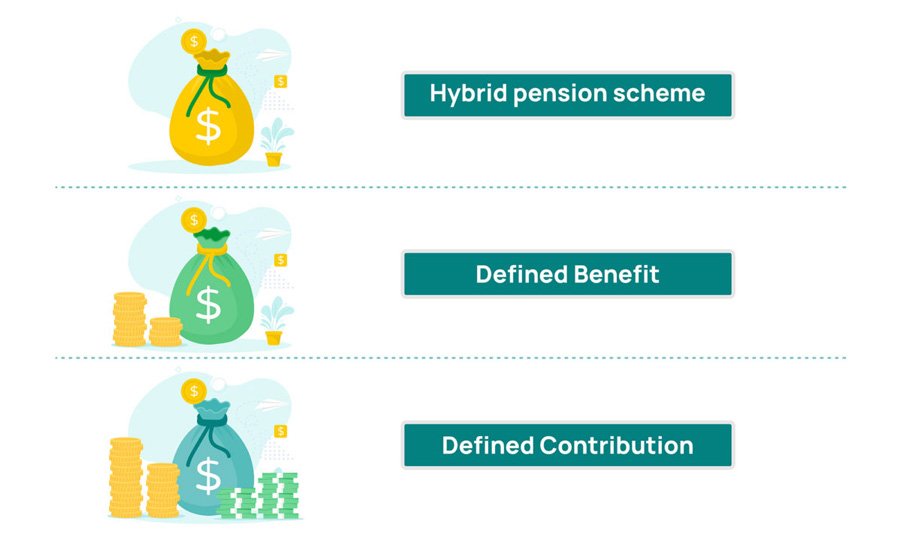Occupational Pensions
Maximizing Benefits: A Comprehensive Guide to Occupational Pensions
Navigating occupational pensions can be complex but it’s pivotal for ensuring a sustainable income in retirement. Whether you’re just starting your career or nearing retirement, understanding these employer-provided pension schemes will help secure your financial future. This article breaks down the fundamentals of occupational pensions, covering how they function, their types, and ways to maximize your benefits. Uncover essential insights that will empower you to make the most of your occupational pension plan.
Key Takeaways
Occupational pension schemes provide long-term financial security for employees by providing a regular income in retirement and may include Defined Benefit, Defined Contribution, or Hybrid schemes.
Employees can benefit from increased pension contributions through Additional Voluntary Contributions (AVCs) and tax relief, enhancing their retirement fund’s growth.
Members of occupational pension schemes have rights to information, participation in decision-making, and various options for accessing their pension at retirement or when changing jobs.
Understanding Occupational Pensions
Picture Sarah, a diligent employee in a prominent Irish company. After years of hard work, she looks forward to a comfortable retirement. But how does she ensure this? Her secret weapon is an occupational pension scheme. These employer-provided plans offer financial security by giving employees like Sarah a regular income during retirement, ensuring she can enjoy her golden years without financial worries.
But it’s not just about the regular income. Sarah also has a personal pension plan, like a Personal Retirement Savings Account (PRSA). Together, her occupational pension scheme and personal retirement savings accounts fortify her financial stability, although simultaneous tax benefits for contributions to both may not be available.
Occupational Pension Scheme Basics
Sarah’s occupational pension scheme works like a well-oiled machine. Contributions from Sarah and her employer flow into a designated fund. From this fund, benefits will be paid out to Sarah during her retirement. As a pension scheme member, she is privy to the scheme’s rules and has the opportunity to voice her preferences on investment strategies.
The contributions made to the scheme are based on her pensionable pay, which refers to the earnings used to calculate contributions to, and benefits from, the scheme.
The Importance of Occupational Pensions for Retirement Planning
Why does Sarah swear by her occupational pension scheme? Well, these schemes often take the state pension into account when calculating retirement benefits. This ensures that Sarah will have a more secure and substantial retirement income, allowing her to maintain her lifestyle without undue financial stress.
Navigating Different Types of Occupational Pension Schemes
Just like there are different roads to a destination, there are different types of occupational pensions that Sarah could choose from. Each type, be it Defined Benefit, Defined Contribution, or Hybrid schemes, has unique features and benefits.
Diving into Defined Benefit Schemes
One road Sarah could take is a Defined Benefit scheme. This scheme promises a specific pension payout, like a pot of gold at the end of the rainbow. The payout is based on factors such as Sarah’s earnings and length of service. It’s a bit like a promise from her employer - for every year she works and every euro she earns, she is guaranteed a certain pension benefit when she retires.
Understanding Defined Contribution Schemes
A second route for Sarah is the Defined Contribution scheme. Here, both Sarah and her employer contribute a fixed percentage to her pension fund. What sets this scheme apart is that the final pension benefit is not predetermined. It is influenced by the contributions made and the performance of the investments made by the pension fund.
It’s a bit like a journey where the destination is not fixed, but the commitment to keep moving forward is.
Hybrid Schemes: Combining Features for Flexibility
The third path is a Hybrid scheme, a blend of the Defined Benefit and Defined Contribution schemes. This scheme shares the characteristics of both, allowing risks to be shared between employers and employees. It provides retirees with a lump sum at retirement, which can be converted into an annuity, with the account balance potentially being protected from direct investment return volatility.
Eligibility and Membership in Occupational Pension Schemes
Who can join these company pension plans, also known as occupational pension schemes? Well, employees of the organization offering the plan, or occupational pension scheme members, are typically eligible, but specific rules are outlined by each individual scheme.
So, whether you’re a full-time worker like Sarah, a part-time worker like her colleague Mark, or a temporary worker like their intern Jake, you can become a member of an occupational pension scheme.
Criteria for Joining an Occupational Scheme
In Ireland, the criteria for joining an occupational pension scheme are quite flexible. Full-time, part-time, and temporary workers can all become members. So, whether you’re a seasoned veteran in your field or a newbie, an occupational pension scheme can be part of your financial plan.
Exclusions and Limitations
However, there might be some roadblocks on your way to joining an occupational pension scheme. Certain categories of employees, like directors of investment companies owning 20% or more of the company, are usually ineligible. Independent contractors and consultants, who don’t have a formal employment relationship with the employer, also can’t join.
But fear not, for the new Auto-enrolment scheme, starting in late 2024, will require employers to enrol certain employees not participating in a pension plan, thus expanding the coverage of pension schemes.
Maximizing Your Pension Contributions
Now that you’re a part of an occupational pension scheme, how do you make the most out of it? The answer is simple - maximize your pension contributions! By increasing their pension contributions, employees can ensure they receive the full match offered by their employer, maximizing the total contribution to their pension fund.
But there’s more - you can also leverage Additional Voluntary Contributions (AVCs) and avail of advantageous tax relief!
Leveraging Additional Voluntary Contributions (AVCs)
Think of AVCs as your secret weapon to supercharge your pension savings. These are extra contributions you make, over and above your regular contributions. And the best part? You have the flexibility to determine your own rate of AVC contribution, within the maximum limits set by the Revenue.
By making AVCs, you can increase your pension savings and fully utilize the tax relief available based on your age and earnings.
Tax Benefits and Relief on Contributions
Let’s talk about the cherry on top - income tax relief. Employees are eligible for tax relief on pension contributions at their marginal tax rate, enabling higher rate taxpayers to invest €100 for €60, and standard rate taxpayers to invest the same amount for €80.
Occupational pension schemes maximize tax efficiency for employees which facilitates faster pension growth, aided by employer contributions.
Rights and Protections for Scheme Members
Now, let’s shift gears and talk about your rights and protections as a member of an occupational pension scheme. You have the following rights:
To receive information about your pension
To be involved in the scheme
To vote for trustee elections, with each member holding the right to select a minimum of two trustees.
Access to Information and Transparency
As a member of an occupational pension scheme, you’re entitled to:
An annual pension benefit statement. This statement contains important information about your contributions and the estimated benefits you can expect at retirement.
The right to know where your contributions are invested.
The right to know whether more than 5% of the scheme’s assets are invested in the employer’s business.
Participation in Decision-Making Processes
Your voice matters! As a member, you can be involved in the scheme’s decision-making processes. You can elect up to half the total number of trustees, with a minimum of two being elected by the members.
Preparing for Retirement: Claiming Your Occupational Pension
You’ve worked hard, saved diligently, and now it’s time to reap the benefits. Claiming your pension benefits at retirement involves several options. You can choose to take a tax-free lump sum payment, receive a regular income (an annuity to provide a stable income for life), or even transfer your savings to an Approved Retirement Fund (ARF).
Early Retirement and Pension Access
What if you choose to retire early? The good news is that early retirement is an option within these pension schemes from as early as age 50 up to 60, allowing for retirement before reaching the standard retirement age.
Transitioning Between Jobs: Preserving Your Pension Benefits
What happens to your occupational pension when you change jobs? You have several options to preserve your pension benefits. You can choose to leave your benefits within the existing pension scheme, transfer your benefits to a new employer’s scheme, or even request a refund of your pension contributions.
Preserved Benefit Options
Leaving your benefits within your old employer’s scheme is known as preserving your benefits. This means that you can claim your pension upon reaching the scheme’s retirement age.
Transferring Your Pension to a New Scheme
Transferring your pension benefits to a new scheme is another option. This can be advantageous as it allows you to consolidate your retirement savings and have greater control over your pension fund. But be aware of the varying rules and restrictions that can affect your decision and the transfer process.
Employer's Role and Responsibilities
Employers play a crucial role in providing access to pension schemes, managing contributions, and ensuring compliance with regulations. They are responsible for entering into a contract with a PRSA provider if they do not offer an occupational pension scheme.
Employer Contributions and Scheme Funding
In contributory occupational pension schemes, employers join employees in making contributions towards the scheme. Employers also bear the responsibility of ensuring that the scheme is sufficiently funded to meet the promised level of benefits.
Providing Information and Support to Employees
Employers also have the responsibility of providing information and support to employees regarding the pension scheme. They must ensure that employees receive an annual report detailing the scheme’s performance and any significant changes that could impact the members.
Summary
Congratulations on navigating the world of occupational pensions! You’ve learned about the importance of these pension schemes, the different types, and how to maximize your contributions. You’ve also understood your rights and protections as a scheme member, how to claim your pension at retirement, and what happens to your pension when you change jobs. Now, armed with this knowledge, you’re well-equipped to make the most of your occupational pension and secure a comfortable and financially stable retirement.
Frequently Asked Questions
How do I know if I have an occupational pension?
To know if you have an occupational pension, ask the trustees of the scheme or your employer for information. If your employer doesn't offer an occupational scheme, consider other options like personal pensions or PRSAs.
Is PRSI payable on occupational pension?
No, PRSI is not payable on occupational pensions. However, occupational pensions are subject to the Universal Social Charge (USC) if you are under 66. Personal and occupational pensions are liable to Income Tax and Universal Social Charge (USC) and may also be liable to PRSI.
What is the retirement age for occupational pension schemes?
The retirement age for occupational pension schemes typically falls between 60 and 70 years old. Early retirement may be possible between the ages of 50 and 60, but it typically requires leaving employment to start receiving benefits.
What are occupational pension schemes?
Occupational pension schemes, also known as company or employers’ pension plans, are provided by employers to offer financial security to their employees after retirement. They are designed to help employees save and invest for their future.
What are the different types of occupational pension schemes?
The main types of occupational pension schemes are Defined Benefit, Defined Contribution, and Hybrid schemes. Each type has its own features and benefits.











